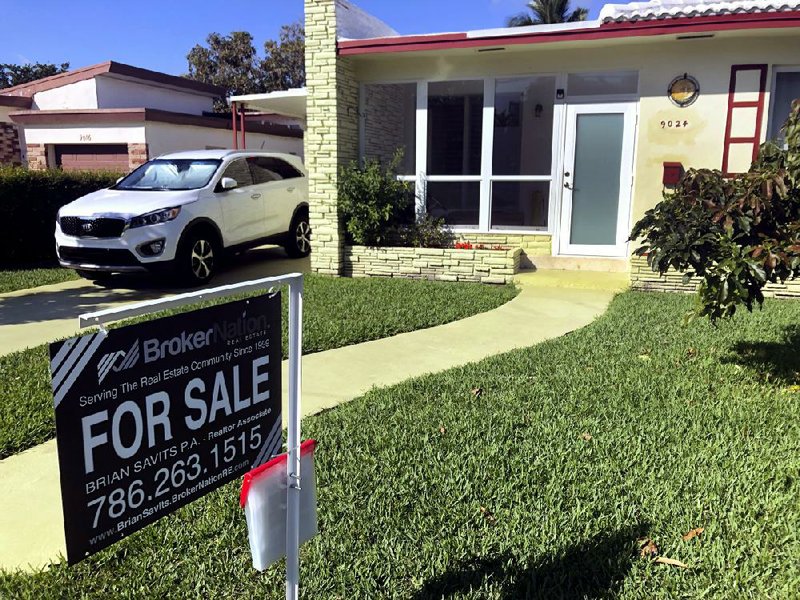WASHINGTON -- There was a 5.2% jump in Americans signing contracts to buy homes in January from the previous month as lower mortgage rates and a solid economy are pushing up demand for housing.
The National Association of Realtors said Thursday that its index of pending sales climbed to 108.8 last month. These contract signings -- a barometer of finalized purchases over the next two months -- have risen 5.7% over the past year.
Homebuyers have benefited from a steady drop over the past year in the average interest charged on a 30-year mortgage. This has improved affordability for buyers with sufficient savings. But sales growth might also be restricted by a historically low inventory of homes for sales and prices that are climbing faster than wages.
January's bounce was the biggest rise since October 2010.
The rebound from December's steepest drop in almost a decade is the latest sign housing remains supported by mortgage rates hovering around a three-year low as well as a solid job market and steady pay gains. Further stabilization in residential real estate may foreshadow a more robust spring selling season that could support economic growth for yet another quarter.
Other housing data, including construction and new-home sales, has strengthened recently. Sales of existing properties remained solid in January, while new-home sales reached the strongest pace since mid-2007.
"This month's solid activity -- the second-highest monthly figure in over two years -- is due to the good economic backdrop and exceptionally low mortgage rates," Lawrence Yun, the association's chief economist, said in a statement. "We are still lacking in inventory."
December contract signings were revised to a 4.3% decline from a previously reported 4.9% drop.
Signings last month increased in all regions but the West. The index of pending sales jumped 8.7% in the South, the biggest region, to the highest level since March 2006.
Federal Reserve interest-rate cuts have helped push mortgage rates down, and plunging government bond yields may help to keep borrowing costs low.
According to the latest data, the 30-year fixed-rate average fell to 3.45% with an average 0.7 point, mortgage buyer Freddie Mac -- the Federal Home Loan Mortgage Corp. -- said Thursday. (Points are fees paid to a lender equal to 1% of the loan amount and are in addition to the interest rate.) It was 3.49% a week ago and 4.35% a year ago.
The 15-year fixed-rate average dropped to 2.95% with an average 0.8 point. It was 2.99% a week ago and 3.77% a year ago. The 15-year fixed average has remained below 3% for the past four weeks.
The five-year adjustable-rate average went down to 3.2% with an average 0.2 point. It was 3.25% a week ago and 3.84% a year ago.
The financial markets were rattled this week by intensified fears about the coronavirus outbreak. On Tuesday, the Centers for Disease Control and Prevention warned that the spread of the virus is "inevitable" within the United States. The Dow Jones Industrial Average sank nearly 1,200 points Thursday. Bond prices soared again, sending the yield on the 10-year Treasury to another record low. It was the third day in a row the yield sank to a new low.
"There is fear in the market," said Mitch Ohlbaum, president of Macoy Capital Partners in Los Angeles. "The flood into Treasurys is not anything new, it is the safest and most liquid asset in the world today and where everyone wants to park money in times of distress or the unknown."
Mortgage rates are influenced by several factors but the movement of the 10-year Treasury tends to be one of the best indicators of where they are headed. When yields go down, rates tend to also go down.
"Mortgage rates, which generally follow the 10-year note, fell, too, but not by as much as these conditions would normally indicate," said Matthew Speakman, a Zillow economist. "Generally, lenders tend not to keep up with volatile movement in Treasurys like those seen in the past few days, particularly with rates as low as they currently are, opting instead to quote conservative rates and wait until the storm passes. So while mortgage rates are likely to remain low as the breadth of the coronavirus outbreak continues to be digested, any downward movement will be muted compared to that of the 10-year yield."
Michael Becker, branch manager at Sierra Pacific Mortgage in Lutherville, Md., pointed out that when the 30-year fixed-rate average sank to its lowest point, 3.31% in 2012, conditions were different.
"People expecting mortgage rates to be at all-time lows based on Treasury yields forget that when mortgage rates were at all-time lows the Federal Reserve was buying billions of mortgage-backed securities every month," Becker said. "Without that, it's hard to see rates dropping to all-time lows."
Coronavirus news overtook strong economic data that normally could have pushed rates higher. Sales of new homes jumped 7.9%, to 764,000, in January, the highest level since July 2007.
Bankrate.com, which puts out a weekly mortgage rate trend index, found that nearly two-thirds of the experts it surveyed predict that rates will continue to fall in the coming week.
"Mortgage rates are down and won't turn back up until investors feel the spread has slowed and containment efforts are working," said Greg McBride, chief financial analyst at http://Bankrate.com.
Information for this article was contributed by Josh Boak, Stan Choe, Alex Veiga, Damian J. Troise and Christopher Rugaber of The Associated Press; by Jeff Kearns and Reade Pickert of Bloomberg News; and by Kathy Orton of The Washington Post.
Business on 02/28/2020
